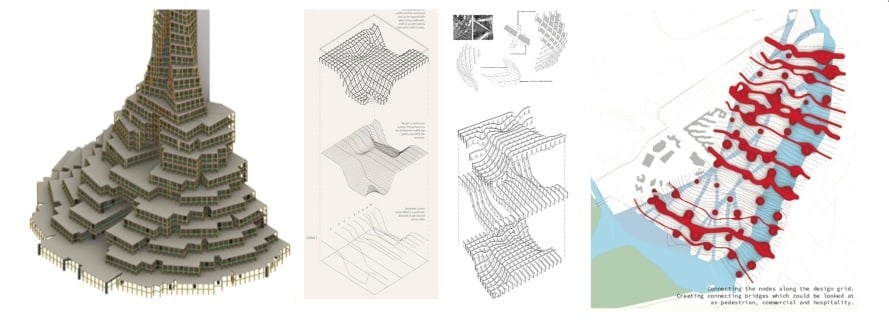
In architecture, success has usually been tied to one golden rule: finish your B.Arch and pursue your M.Arch. But that’s no longer the case; the rulebook is being rewritten, and architects today are proving that you don’t need a Master's to design a stellar career.
This blog isn’t about skipping steps. It’s about choosing the right steps. The kind that aligns with today’s design industry, where agility, software fluency, and collaboration are valued more than long academic credentials.
From building foundational skills and gaining practical experience to exploring new-age certification programs, such as those offered by Novatr, this is your guide to navigating the world of architecture without following the traditional Master’s route.
So, let’s ditch the “one-size-fits-all” mindset.
Understanding the Architectural Profession
What does an architect do, and how can you become one without a Master’s?
Forget the stereotype of architects simply sketching pretty buildings. The reality? Architecture is where vision meets precision, and creativity collides with constraint.
Roles and Responsibilities:
Architects are problem-solvers, collaborators, and strategic thinkers. Their responsibilities go beyond design and include:
- Conceptualising structures that meet both aesthetic and functional goals
- Creating detailed drawings and working with BIM software
- Coordinating with civil engineers, consultants, and clients
- Managing timelines, budgets, and sustainability requirements
- Visiting construction sites to ensure accurate execution
Core Skills:
To succeed, you need to hone:
- Design Thinking: The ability to solve spatial and structural challenges innovatively
- Technical Proficiency: Familiarity with tools like Revit, Rhino, SketchUp, and AutoCAD
- Project Communication: Presenting ideas clearly to clients and teams
- Team Collaboration: Working across disciplines (BIM can help you in this!)
- Adaptability: Staying relevant as the industry evolves
Your career doesn’t need to begin with a Master's. But it needs to begin with mastery. And that starts with understanding your role in shaping the built world.
Educational Foundations: Beyond the Master’s Degree
You don’t need another degree; rather, you need the right knowledge.
While a Master's degree may offer academic depth, it isn’t the only way to build a strong foundation in architecture. What counts is how you learn, what you know, and how fast you can apply it.
Your B.Arch already gives you the basics from design principles and history to construction methods. What comes next doesn’t have to be two more years of lectures. Instead, consider a skill-first model that focuses on today’s needs, not yesterday’s syllabi.
Here’s how to strengthen your foundation without a Master’s:
- Self-Learning: Dive into architecture books, tutorials, podcasts, and online lectures. Stay curious.
- Skill-Based Learning: Focus on tools like Revit, Rhino, and Grasshopper, skills that many M.Arch programs don’t prioritise.
- Project Work: Take part in design competitions or conceptual projects. These sharpen your creativity and build your portfolio.
And here’s where Novatr changes the game. Its programs don’t ask for two years of your time. In just 7 months, you can master BIM, get mentored by global experts, and work on real-world projects. That’s education designed for application, not just for name's sake.
You don’t need a Master’s to go deep. You just need to go smart.
Alternative Pathways to Licensure
Yes, you can get licensed without a Master’s. Here’s how.
Contrary to popular belief, a Master’s degree is not a mandatory step toward becoming a licensed architect in India. What you do need is the right combination of education, experience, and examination.
Here’s a breakdown of how you can pursue licensure post-B.Arch:
- COA Registration: After completing your B.Arch from a recognised institute, you’re eligible to register with the Council of Architecture (COA), the official body regulating architectural practice in India.
- Practical Experience: Many firms expect 1–2 years of hands-on experience before giving you independent responsibilities, but this doesn’t require a Master’s. Internships, freelance projects, and full-time roles are also valid..
- Certifications and CPD (Continuing Professional Development): These allow you to stay compliant, skill-ready, and professionally active, especially through platforms like Novatr, which offer globally relevant credentials and mentorship.
Licensure is about meeting professional standards, not collecting degrees. Focus on real experience, industry-aligned learning, and a strong portfolio, and you’ll be well on your way to sealing your title as “Architect.”
Building Practical Experience
“Your site visits will teach you more than most textbooks ever could.”
- A wise Architect
In architecture, experience isn’t a bonus; rather, it’s the blueprint for your career. Whether or not you pursue a Master’s, what truly sets you apart is your ability to do the job, not just talk about it.
Here’s how to build hands-on experience that matters:
- Start Early and Stay Active: Don’t wait for the “perfect” role. Intern during college, assist with freelance projects. Every opportunity adds to your learning.
- Work with Small and Mid-Sized Firms: These firms often allow junior architects to work across design, client communication, and site execution, exposing you to the full project cycle.
- Document Your Work: Maintain records of everything from drawings, site photos, models, to feedback. This not only improves your skills but builds a rich portfolio.
With Novatr, even your learning is practical. Their project-based curriculum ensures you apply your skills to real-world briefs under expert mentorship, so you're not just learning software, you're simulating studio life.
The best architects aren’t just educated, they’re experienced. Start building before you think you’re ready.
Specialised Certifications and Courses
Shorter, sharper, and smarter than a Master’s degree.
The architecture world is evolving faster than ever…think BIM, AI in design, parametric workflows, sustainable materials. And while traditional Master’s programs can take years to catch up, certification programs are already there.
Here’s why specialised courses are your secret weapon:
- Focused Learning: Unlike Master’s programs that blend theory and electives, certifications are targeted. You learn exactly what the industry wants.
- Software Mastery: From Revit and Rhino to Grasshopper and Enscape, certifications let you dive deep into the tools top firms use everyday.
- Affordability and Accessibility: Most programs are online, flexible, and cost a fraction of a full-time degree.
- Portfolio-Centric: The best certifications are project-based. You don’t just get a certificate; rather, you graduate with a portfolio that proves your skills.
- Mentorship and Community: Programs like those by Novatr connect you with global mentors and peers, offering feedback, industry insights, and job support.
If you're looking to upskill quickly and become job-ready in months (not years), certifications are the smart, strategic alternative. Think of them as micro-degrees with macro impact.
Why wait two years for a title when you can earn real skills in seven months?
Novatr: A Modern Alternative to Traditional Master’s Programs
What if the future of architectural education didn’t take two years but just seven months?
In an industry shifting toward agility, tech-savviness, and real-world application, Novatr stands out as the smarter, faster, and more relevant alternative to the traditional Master’s degree.
Here’s what makes Novatr more than just an online course:
- Future-Focused Curriculum: Whether it’s BIM, parametric design, or sustainable workflows, Novatr’s content is designed with the industry, not just for it.
- Global Mentors, Real Projects: Learn from architects at firms like AECOM, and BIG, RAMBOLL. And work on hands-on projects that reflect the challenges of a modern design studio.
- Portfolio-First Approach: Every course culminates in a portfolio-ready project. That means you walk away with tangible proof of your skills, not just a certificate.
- Career Launch Support: Resume building, 1:1 mentorship, placement guidance, meaning, Novatr doesn’t just teach, it transforms your career trajectory.
- Built for Busy Learners: Whether you're freelancing, working full-time, or fresh out of college, Novatr’s flexible structure fits into your life and not the other way around.
In short, Novatr’s BIM Professional Course for Architects is what architectural education should be like: accessible, practical, and deeply connected to where the industry is heading.
Conclusion
You don’t need a Master’s degree. You need a master plan.
The architecture industry is no longer bound by tradition. Firms are no longer asking, “Where did you study?” Rather, they’re asking, “What can you do?” That means your dream career doesn’t need to follow the same old blueprint. It needs bold moves, the right skills, and a mindset that thrives on evolution.
- Visit the Novatr Homepage to understand our mission in transforming AEC education.
- Browse through our Courses Page to find specialised programs tailored for architects and designers.
Dive into the Learning Hub for in-depth insights, industry trends, and expert resources to stay ahead in the field.
FAQs
1. How can I enhance my architectural skills without a Master’s degree?
By focusing on hands-on experience, mastering industry-relevant software, and pursuing project-based certifications like those from Novatr that prioritise real-world learning over academic theory.
2. Are there successful architects who didn’t pursue a Master’s degree?
Yes, many architects have built thriving careers through experience, strong portfolios, and self-driven learning.
3. Can I specialise in fields like urban planning or interior design without a Master’s?
Absolutely. With targeted certifications and project experience, you can specialise in areas like urban planning, interior design, or sustainability without needing a formal Master’s.
4. How does Novatr support aspiring architects without a Master’s degree?
Novatr offers future-focused, mentor-led programs that teach tools like BIM and parametric design, in return empowering architects with skills, portfolios, and career guidance to succeed without a Master’s.
5. What are the benefits of choosing alternative pathways over a traditional Master’s?
Alternative paths are faster, more affordable, and aligned with industry needs, offering practical skills, flexibility, and direct career opportunities without years of academic investment with anticipated ROI.
Was this content helpful to you











.png)

.png)